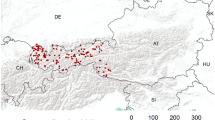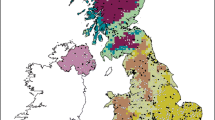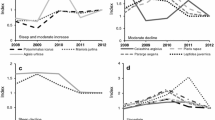Abstract
Many butterfly species that were historically common throughout the UK are thought to have declined due to land use intensification, whilst others have increased regionally due to climate change. Population trends in these species are inadequately assessed by current monitoring programmes: the UK Butterfly Monitoring Scheme (UKBMS) mainly samples semi-natural habitats; coarse-scale distribution recording under-estimates declines in population abundance. We designed a scheme (the wider countryside butterfly survey—WCBS) to provide unbiased abundance trends for widespread butterfly species across the whole countryside. The WCBS has been developed over a 3 year pilot study, culminating in a UK-wide roll out in 2009. After testing a range of survey methods, the scheme involves visiting randomly selected 1-km squares at least twice during July–August and walking a linear transect route, counting the number of individual butterflies seen within 5 m. A method for volunteer recorders to collect abundance data on non-lepidopteran insects was also tested. The results of the first year of the WCBS and future plans for the scheme will be described.



Similar content being viewed by others
References
Aebischer NJ, Evans AD, Grice PV, Vickery JA (2000) Ecology and conservation of lowland farmland birds. British Ornithologists Union, Tring
Asher J, Warren MS, Fox R, Harding P, Jeffcoate G, Jeffcoate S (2001) The millennium atlas of butterflies in Britain and Ireland. Oxford University Press, Oxford
Buckland ST (2006) Point transect surveys for songbirds: robust methodologies. Auk 123:345–357
Buckland ST, Anderson DR, Burnham KP, Laake JL, Borchers DL, Thomas L (2001) Introduction to distance sampling estimating abundance of biological populations, Oxford University Press, Oxford
Buckland ST, Magurran AE, Green RE, Fewster RM (2005) Monitoring change in biodiversity through composite indices. Philos Trans R Soc B 360:243–254
Carey PD, Wallis S, Chamberlain PM, Cooper A, Emmett BA, Maskell LC, McCann T, Murphy J, Norton LR, Reynolds B, Scott WA, Simpson IC, Smart SM, Ullyett JM (2008) Countryside survey: UK results from 2007. NERC/Centre for Ecology & Hydrology, 105 pp
Conrad KF, Warren MS, Fox R, Parsons MS, Woiwod IP (2006) Rapid declines of common, widespread British moths provide evidence of an insect biodiversity crisis. Biol Conserv 132:279–291
Cowley MJR, Thomas CD, Thomas JA, Warren MS (1999) Flight areas of British butterflies: assessing species status and decline. Proc R Soc B 266:1587–1592
Defra (2006) Working with the grain of nature–taking it forward: volume II. Measuring progress on the England Biodiversity Strategy: 2006 assessment. Defra, London
Donald PF, Green RE, Heath MF (2001) Agricultural intensification and the collapse of Europe’s farmland bird populations. Proc R Soc B 268:25–29
Firbank LG, Petit S, Smart S, Blain A, Fuller RJ (2008) Assessing the impacts of agricultural intensification on biodiversity: a British perspective. Phil Trans R Soc B 363:777–787
Fox R, Asher J, Brereton T, Roy DB, Warren MS (2006) The state of butterflies in Britain and Ireland. Pisces, Newbury
Fox R, Warren MS, Brereton TM (2010) A new red list of British butterflies, species status, vol 12. Joint Nature Conservation Committee, Peterborough, pp 1–32
Fuller RM, Smith GM, Hill RA, Thomson AG (2002) The UK Land Cover Map 2000: construction of a parcel-based vector map from satellite images. Cartograph J 39:15–25
Greatorex-Davies JN, Roy DB (2001) The butterfly monitoring scheme progress report for 2000/2001. Joint nature conservation committee contract report. NERC Centre for Ecology and Hydrology, Huntingdon
Greenwood JJD, Baillie SR, Gregory RD, Peach WJ, Fuller RJ (1995) Some new approaches to conservation monitoring of British breeding birds. Ibis 137:S16–S28
Groombridge B (1992) Global biodiversity: status of the Earth’s living resources. Chapman & Hall, London
Jackson DL (2000) Guidance on the interpretation of the biodiversity broad habitat classification (terrestrial and freshwater types): definitions and the relationship with other habitat classifications. JNCC Report, No. 307. JNCC, Peterborough
Kéry M, Plattner M (2007) Species richness estimation and determinants of species detectability in butterfly monitoring programmes. Ecol Entomol 32:53–61
Krebs JR, Wilson JD, Bradbury RB, Siriwardena GM (1999) The second silent spring? Nature 400:611–612
Leon-Cortes JL, Cowley MJR, Thomas CD (1999) Detecting decline in a formerly widespread species: how common is the common blue butterfly Polyommatus icarus? Ecography 22:643–650
León-Cortés JL, Cowley MJR, Thomas CD (2000) The distribution and decline of a widespread butterfly Lycaena phlaeas in a pastoral landscape. Ecol Entomol 25:285–294
Newson SE, Evans KL, Noble DG, Greenwood JJD, Gaston KJ (2008) Use of distance sampling to improve estimates of national population sizes for common and widespread breeding birds in the UK. J Appl Ecol 45:1330–1338
Pellet J (2008) Seasonal variation in detectability of butterflies surveyed with Pollard walks. J Insect Conserv 12:155–162
Pollard E (1977) A method of assessing changes in the abundance of butterflies. Biol Conserv 12:115–134
Pollard E, Greatorex-Davies JN (1997) Butterfly monitoring scheme: review and suggestions for the future. CEH, Huntingdon
Pollard E, Yates TJ (1993) Monitoring butterflies for ecology and conservation. Chapman and Hall, London
Pollard E, Moss D, Yates TJ (1995) Population trends of common British butterflies at monitored sites. J Appl Ecol 32:9–16
Pywell R, Warman EA, Sparks TH, Greatorex-Davies NJ, Walker K, Meek WR, Carvell C, Petit S, Firbank LG (2004) Assessing habitat quality for butterflies on intensively managed arable farmland. Biol Conserv 118(3):313–325
Roy DB, Rothery P, Moss D, Pollard E, Thomas JA (2001) Butterfly numbers and weather: predicting historical trends in abundance and the future effects of climate change. J Anim Ecol 70(2):201–217
Roy DB, Rothery P, Brereton TM (2007) Reduced-effort schemes for monitoring butterfly populations. J Appl Ecol 44:993–1000
UK BAP (2007) UK list of priority species and habitats. Available at http://www.ukbap.org.uk/newprioritylist.aspx
UK Biodiversity Partnership (2007) Conserving biodiversity—the UK approach. Defra, London
van Dyck H, van Strien AJ, Maes D, van Swaay CAM (2009) Declines in common, Widespread Butterflies in a Landscape under Intense Human Use. Conserv Biol 23(4):957–965
van Swaay CAM (1990) An assessment of the changes in butterfly abundance in the Netherlands during the 20th century. Biol Conserv 52:287–302
van Swaay CAM, Plate CL, Van Strien A (2002) Monitoring butterflies in the Netherlands: how to get unbiased indices. Proc Sect Exp Appl Entomol Neth Entomol Soc 13:21–27
van Swaay CAM, Warren MS, Loıs G (2006) Biotope use and trends of European butterflies. J Insect Conserv 10:189–209
van Swaay CAM, Nowicki P, Settele J, van Strien AJ (2008) Butterfly monitoring in Europe: methods, applications and perspectives. Biodivers Conserv 17:3455–3469
Vickery JA, Evans AD, Grice P, Brand-Hardy R, Aebischer NA (2004) Ecology and conservation of lowland farmland birds II: the road to recovery. Ibis 146(Suppl. 2):1–258
Acknowledgments
Funding was provided to develop the WCBS through the UKBMS project (WCO2014 and BD1453) by a consortium of government agencies including Defra, the Joint Nature Conservation Committee, Natural England, Countryside Council for Wales, Natural Environment Research Council, Scottish Natural Heritage, Scottish Executive Environment and Rural Affairs Department, Northern Ireland Environment Agency and the Forestry Commission. We are grateful to the continued support from BC and BTO/JNCC/RSPB Breeding Bird Survey recorders and co-ordinators. We are grateful to many for helpful discussions of field and analytical methods including Valerie Brown, Nick Greatorex-Davies, Roger Dennis, Keith Porter, Richard Pywell, Peter Rothery, Helen Roy, David Sheppard, Tim Shreeve, Mark Stevenson, Chris Thomas, Lawrence Way and Rob Wolton. Help with fieldwork in the pilot studies was given by Julian Hughes, Poppy Lakeman-Fraser, Ian Middlebrook, Thomas Mills, Helena Romo, Silvia Ruggieri, and Duncan Stewart and Sarah Walley, with permission from the Lulworth Estate and the tenant farmer, Paul Simpson. Finally, thanks to Martin Warren for commenting on an earlier version of this manuscript.
Author information
Authors and Affiliations
Corresponding author
Rights and permissions
About this article
Cite this article
Brereton, T.M., Cruickshanks, K.L., Risely, K. et al. Developing and launching a wider countryside butterfly survey across the United Kingdom. J Insect Conserv 15, 279–290 (2011). https://doi.org/10.1007/s10841-010-9345-8
Received:
Accepted:
Published:
Issue Date:
DOI: https://doi.org/10.1007/s10841-010-9345-8




